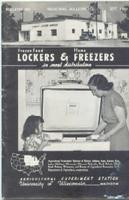Frozen Food Lockers
 I found an unusual booklet in an incoming batch of advertising cookbooks. It's not actually a cookbook, but it is food-related. It's interesting that someone kept it all these years in with their old recipe books.
I found an unusual booklet in an incoming batch of advertising cookbooks. It's not actually a cookbook, but it is food-related. It's interesting that someone kept it all these years in with their old recipe books.The softcover booklet (63 pages) is a 1950 publication, Bulletin 490 from the Agricultural Experiment Station at the University of Wisconsin, with the title "Frozen Food Lockers & Home Freezers in Meat Distribution."
The lower half of the front cover shows a woman and a young girl loading things into an old-fashioned chest freezer. The upper half of the cover shows a nondescript square building with an old car parked out front.
"What the heck is a frozen food locker?" I ask myself. Remember, I'm a city girl and our food came from the Henke's or the A&P. It's possible that if there had been hunters in our family then I might be a bit more informed. I grew up eating fresh Gulf Coast seafood from nearby Galveston and Kemah--no need for freezing--it was always fresh.
A frozen food locker was a storage facility where people rented a small individual space to store large quantities of frozen foods that they didn't have room for at home.
We had a butter yellow Frigidaire refrigerator with the freezer compartment on the bottom. Much like those that the appliance manufacturers are producing again today. That's where we kept our frozen food and it was plenty big enough. Though come to think of it, my aunt's freezer compartment in her old icebox was hardly big enough to hold much more than two ice trays. She could have used a frozen food locker.
According to the booklet, "few business enterprises in the United States have had as rapid growth as the frozen food locker plants. The number of plants increased from 200 in 1935 to approximately 11,000 by the spring of 1948. These plants are of real benefit to rural and urban families in the preservation and storage of meat, fish, fruits and vegetables, and a convenience to many farmers in slaughtering livestock. Along with the growth and developement in recent years of the frozen food locker plants is the development of home freezer units for similar food preservation and storage."
The information in this booklet provides the results of a study that was done to appraise this development and how it might impact the field of livestock marketing, meat distribution and consumption. Nine states in the North Central Region participated and the resulting report provides quite a bit of information on the habits of consumers and their food freezing habits in these areas during this time period.
Maybe the previous owner of this book was thinking of starting a plant of their own and needed to get the scoop.
I Googled and came up with a website that tells the history of the American Association of Meat Processors. This trade organization was previously known as the National Frozen Food Locker Institute (NFFLI) and it gives a nicely illustrated history of the food lockers.
If you're in the dark like I was, you might find the history interesting.

0 Comments:
Post a Comment
<< Home